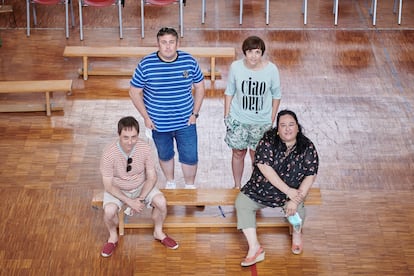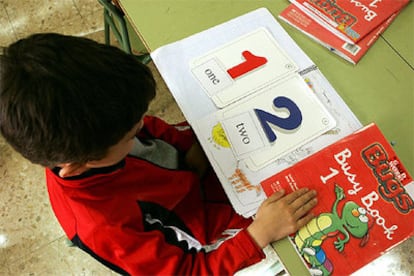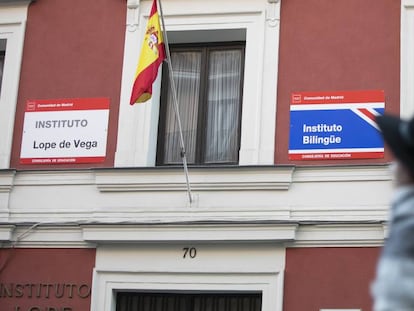The Spanish schools dropping out of bilingual education programs: ‘It’s a sham’
Nearly 90 primary and secondary centers are no longer teaching courses in English because they say students learn neither the language nor the subject matter properly


Rubén García, a 39-year-old teacher in the Spanish city of Valladolid, worries about the fact that he needs to resort to US country-pop diva Taylor Swift in order to teach his students about natural science. García teaches at a public primary school offering a bilingual education, and the first time that his students look at a picture of a bird named “swift” in English, he finds himself talking about the singer in order to help them remember the word.
Just like other educators, García believes that Spain’s bilingual education program has significant shortcomings. One of the big problems he sees is that both the vocabulary and the grammar in the science books are more advanced than what students are learning in their regular English language class. This means that kids have trouble understanding what they are reading, and in the end they just memorize the words without really grasping the content.
The center where he works, the Antonio Allúe Morer primary school, is one of seven public schools that are dropping out of the bilingual program in the Spanish region of Castilla y León, where there are 374 centers on a system that was introduced in the 2006-2007 academic year.
In another large region of Spain, Castilla-La Mancha, 80 out of 271 schools have abandoned the model, which was first adopted there in the 2005-2006 academic year. And in Navarre, where the program began in 2010-2011, a school has for the first time received government authorization to drop out. In Madrid, all new schools need to be bilingual, and some parents report having a hard time finding a center that is not.

In all regions of Spain – which have devolved powers over education – a school can only quit the bilingual education program if the school bodies representing teachers, families and students are in agreement about the matter.
So why are so many schools opting out of one of Spain’s big education initiatives, which was backed by political parties of various ideologies? Antonio Cabrales, a researcher at Carlos III University and author of the 2017 report Evaluating a bilingual education program in Spain, believes the Spanish curriculum has too much content to begin with, and added to this is the fact that some courses are being taught in English by teachers who are not native speakers.
The bilingual education boom has remained strong ever since regional governments first introduced the concept in the early 2000s, allowing public schools and semi-private ones that receive public funding (known as concertados) to sign up on a voluntary basis. There were 240,154 students registered in these programs in 2010-2011 in all Spanish regions – except for Catalonia, which does not provide figures. By the 2019-2020 academic year, there were 1.4 million students in a bilingual school program, representing a rise of 498%, according to an analysis by EL PAÍS using Education Ministry data. There are a total of 8.2 million students in non-university education in Spain. Of these, 17.3% are enrolled in a bilingual program, and 95.8% of them have chosen English as their other learning language.
But experts say there is a lack of objective information on the effects of this learning model on students. They also accuse regional authorities of using schools as a testing ground to fulfil their campaign promises.
There are also differences between the English requirements for teachers depending on the region. In Asturias and Andalusia, it is enough to have a B2 level, which indicates fluency but not proficiency as defined by the Common European Framework of Reference for Languages (CEFRL). In Madrid, teachers on the bilingual program need to prove a C1 level, which indicates proficient users of the language.
What we’re doing here is deceitful, it’s a sham, it’s a phony bilingualism where [students] neither learn English nor the subject matter properlyManuel Quevedo, biology teacher in La Roda
Some opponents of the model are educators who participated in the Education Ministry’s exchange program for visiting teachers in the United States and Canada. Manuel Quevedo, a biology teacher at the Doctor Alarcón Santón public secondary school in La Roda (Albacete), was in Evanston (Illinois) for a year, teaching biology in Spanish to English-speaking students. “It was there that I saw the way an efficient, well-designed system works, with five hours a day in Spanish,” he says.
In Spain, students on the bilingual education program get on average five hours a week of subject matter taught in English, not counting their English language classes. “What we’re doing here is deceitful, it’s a sham, it’s a phony bilingualism where [students] neither learn English nor the subject matter properly,” he says.
His school gave up on the program in 2018, just one year after the regional government allowed it. Before that, it was offering biology and physical education in English. “We made a mistake, we sold this to the parents, telling them it would open up opportunities, that there would be gradual progress, but the years went by and we were never sent the native support staff were were promised... and meanwhile teachers were only asked to have a B2 level of English, which is not enough to teach a class fluently. We wanted to do something with a sound basis, but we lacked the capacity.”
If so many people are unhappy with the program, why don’t more schools switch back to all-Spanish learning? Paco Serrano, a primary school teacher in Madrid and author of the documentary La chapuza del bilingüismo (or, The bilingual education mess), notes that one reason could be the fact that teachers do not want to give up on their monthly bonus for teaching in English, which ranges from €80 to €170.
Ainhoa Reparaz is the principal of the only school in the Navarre region that dropped out of the bilingual program, the public center Dos de Mayo in Castejón, where the new system was imposed on them, she says. Under the program, they were being forced to teach natural and social sciences in English. “The kids got lost during the explanations...we’re not against English, but ultimately you are sacrificing courses,” she says. Adding to the learning difficulties is the fact that 50% of students at her school are of Arab descent. “If they are already struggling with the Spanish language, imagine with English.”
There are two schools of thought in the scientific literature regarding the best way to learn languages. One says that the critical period for learning is from birth to seven years of age, a theory that supports having bilingual school models from an early age. Another theory posits that it is better to consolidate the native language before embarking on a second one. In most regions of Spain, the bilingual program begins in primary school, at age six, not in early education, and some experts say this is the real reason it isn’t working.
“The teaching method is failing: it is based on memorizing vocabulary lists at a time when they still can’t read properly in Spanish. They are not being taught the language naturally through conversation, but with books,” laments Tais Martín, 44, mother of a child with dyslexia who now goes to a private school in Madrid because there were no public ones without a bilingual program.
A 2018 study by the Madrid education department on the performance of students from bilingual schools showed that sixth-grade students did two-tenths of a point better on math (which is taught in Spanish) and scored 12 points higher on English language than their peers in a Spanish education program. But everyone performed the same on science subjects.
“The language of science is English; in engineering, mathematics or medicine it is essential in adult life. It is an effort that requires continuity,” says Ismael Sanz, a lecturer of economics at Rey Juan Carlos University in Madrid and a supporter of the bilingual program. “The first generations of that model are now reaching university and the English level has clearly gone up, we are now able to create more degrees in that language.”
But Henar Rubio, the principal of Antonio Allúe Morer school in Valladolid, feels that sacrificing students’ understanding of science in order to improve their English is not a reasonable option. “They learn parts of the body in English, and then they can’t place them or even know what these organs do,” she says. “I don’t think that’s the kind of new generation that we want.”
English version by Susana Urra.
Tu suscripción se está usando en otro dispositivo
¿Quieres añadir otro usuario a tu suscripción?
Si continúas leyendo en este dispositivo, no se podrá leer en el otro.
FlechaTu suscripción se está usando en otro dispositivo y solo puedes acceder a EL PAÍS desde un dispositivo a la vez.
Si quieres compartir tu cuenta, cambia tu suscripción a la modalidad Premium, así podrás añadir otro usuario. Cada uno accederá con su propia cuenta de email, lo que os permitirá personalizar vuestra experiencia en EL PAÍS.
¿Tienes una suscripción de empresa? Accede aquí para contratar más cuentas.
En el caso de no saber quién está usando tu cuenta, te recomendamos cambiar tu contraseña aquí.
Si decides continuar compartiendo tu cuenta, este mensaje se mostrará en tu dispositivo y en el de la otra persona que está usando tu cuenta de forma indefinida, afectando a tu experiencia de lectura. Puedes consultar aquí los términos y condiciones de la suscripción digital.
More information
Últimas noticias
Maduro pleads not guilty before the federal court in New York: ‘I am still the president of Venezuela’
A new test can detect Alzheimer’s from a finger prick
UN team enters Sudanese city of El Fasher after paramilitary massacre: ‘It’s like a ghost town’
A recipe for resistance: Indigenous peoples politicize their struggles from the kitchen
Most viewed
- Gilles Lipovetsky: ‘If you want to live better and fall in love, take Prozac, don’t look to philosophy’
- Alain Aspect, Nobel laureate in physics: ‘Einstein was so smart that he would have had to recognize quantum entanglement’
- Alvin Hellerstein, a 92-year-old judge appointed by Bill Clinton, to preside over Maduro’s trial in New York
- Maduro’s downfall puts China’s relationship with Venezuela to the test
- Why oil has been at the center of Venezuela-US conflicts for decades










































